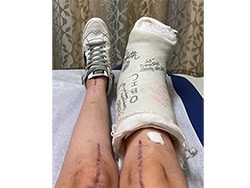Exploring the woods, hiking, summer camp, and regular trips to the dog park were all normal activities growing up in New Jersey. Meghan Bradshaw described herself as a healthy, active young girl with an affinity for the great outdoors. But things changed when she began having sporadic, unrelated health problems like exhaustion, dizzy spells, and body aches. After seeing a wide variety of medical specialists to uncover the root of these issues, her lab results were always inconclusive.

Meghan Bradshaw
Unbeknown to Bradshaw and her doctors, her illness stemmed from a parasite. Bradshaw had contracted Lyme disease, a bacterial infection that can come from the bite of a blacklegged tick — also known as a deer tick — if it stays attached to your body for 36 to 48 hours. Symptoms can include memory loss, joint pain, drooping muscles on one or both sides of your face, and tingling or numbness of your body parts.
Bradshaw’s health continued to worsen as she bounced from the East Coast to the West Coast in her early 20s for work as a retail manager at Nordstrom. It wasn’t until she took a job promotion in Nashville that her illness became debilitating and left her bedridden. She could no longer perform everyday tasks like holding a toothbrush or washing dishes.
Bradshaw’s knees began filling up with fluid. Her doctor diagnosed her with rheumatoid arthritis, which is the closest thing he could think of to explain her “mystery” illness. She had to have her hips replaced at 26 years old.
“It [the disease] was deteriorating every joint in my body,” Bradshaw, now 29, says. “I was a shell of myself. It was terrifying.”
One specialist referred Bradshaw to a functional medicine doctor, who began asking questions about her upbringing. Upon discovering Bradshaw was from New Jersey, where blacklegged ticks are extremely common, her doctor asked a question that changed everything.
“Have you ever been tested for Lyme disease?”
Bionic Woman
Fast forward a few years. Bradshaw has now had 16 of her joints reconstructed and eight joint replacements, all because of the late detection of Lyme disease. She is preparing to have both elbows replaced, along with her second surgery on each hand, all of which should be completed within the next year. Hopefully then, she’ll “catch a break.” But there will likely be more surgeries down the road to replace her joint replacements, she says.
Bradshaw’s experience is extremely rare for Lyme disease patients, says Glenn Gaston, MD, an orthopedic surgeon at OrthoCarolina in Charlotte. Only a small number of Lyme disease patients develop arthritis, especially if it’s treated early, says Gaston, who operated on Bradshaw’s hands. If a patient does get arthritis, it usually only affects one joint, which is often the knee.
“I have never even heard or read in a textbook a case to the degree of Meghan’s, of having to have multiple joint replacements and multiple surgeries, particularly at such a young age,” Gaston says.
When asked why Bradshaw’s Lyme disease diagnosis remained a mystery for so long, Gaston says the disease can be hard to detect.

Meghan Bradshaw has has now had 16 of her joints reconstructed and eight joint replacements, all because of the late detection of Lyme disease.
“The biggest reason I see for delayed detection and treatment of Lyme disease is primarily because it’s not often in the forefront of the minds of clinicians, particularly depending on where a patient lives,” he says. “If they live in Connecticut, which is where Lyme disease comes from (Lyme, Connecticut), it’s more plausible that they’re going to think about it early. The further you get from the epicenter of the diagnosis, the less physicians think about it in their differential.”
If you remove the tick before 48 hours, you likely won’t get the disease. Ticks can be as small as a poppyseed, so spotting them can be hard. But one major sign of a tick bite is a rash that looks like a bull’s eye. If you catch it early, Lyme disease can be treated and cured with antibiotics. But with late detection (like Bradshaw’s), treatment and recovery become much more difficult. Good news: A vaccine to treat Lyme disease is currently in phase III clinical trials with drugmakers Pfizer and Valneva.
Dwelling on what life could have been like if, early on, doctors had asked questions about her upbringing has been one of the most difficult things for Bradshaw to come to grips with.
“I have severe medical trauma and I relive it every 3 months after another traumatic surgery,” she says. “It’s constantly going through the grief cycle.”
Bradshaw is often nicknamed the “bionic woman,” which she finds endearing.
“I use humor as a coping mechanism,” she says. “I have to laugh about it. Because if I don’t laugh, I cry, and this is healthier for me.”
Newfound Purpose
Great health care is one major source of gratitude for Bradshaw. Her surgeries and medical care have racked up over $1 million dollars of medical costs, of which her insurance covered the majority, and she paid the rest out of pocket. Bradshaw often speaks publicly about the lack of access to quality health care for certain marginalized communities, like LGBTQ+ individuals, immigrant groups, and people of color.
“I’m very fortunate I’ve had access to improvement of my conditions,” she says. “A lot of people don’t have a means to an end.”
While it could be easy to become angry, or even resentful, for her late diagnosis, Bradshaw has shifted her focus toward tick-borne disease awareness advocacy, which has been “very healing” for her.
“I can look in hindsight and see all of the things that were wrong in my path and in this experience,” she says. “I’m like, ‘Here is how it should be. And here’s how we can fix it.’ I want to be a part of that.”
Bradshaw recently co-founded a nonprofit organization, Tick JEDI Coalition (JEDI stands for “juvenile educational defense initiative”) that strives to put tick safety education into mainstream health science curricula.
“Children should be learning this [tick safety] as a fundamental life skill, the same way they learn about handwashing,” she says.
Meghan’s Tips
To help avoid late detection of Lyme disease, or any other illness, Bradshaw gives these tips.
You know your body better than anyone.
“Doctors are incredibly brilliant, talented, and knowledgeable about many things. But at the end of the day, everyone is still human. There may be times that you have something that is beyond the scope of their knowledge. If the doctor you see is not the right fit, and you are able to access care elsewhere, do your research and find someone who may be a good fit.”
Utilize patient support groups.
“I think there’s a lot you can learn from other individuals and their experiences, both good and bad things. I found them incredibly helpful in my own experience.”
Have a support person.
“There have been many times, especially at the beginning of my journey, where I was so emotionally distraught dealing with these things. My parents were there to take notes and take in everything for me. Have a support person because it’s hard to do these things alone.”
Editor’s note: Here’s more information on Lyme disease.
Sources:
News release, Business Wire.
Meghan Bradshaw, Lyme disease patient advocate.
Twitter: @cdc, May 4, 2018.
Glenn Gaston, MD, orthopedic surgeon, OrthoCarolina, Nashville.
CDC: “Regions Where Ticks Live.”
Merriam-Webster.com.
Source: Read Full Article
